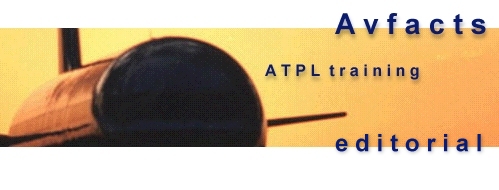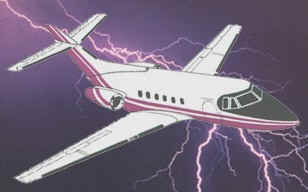




 |
 |
  |
 |
Aircraft Systems Topic 15.
Weather Radar

| General:
Weather radar is a type primary radar, and relies on reflection of pulsed radar (microwave) energy off large water droplets, or water covered hail. Conventional types do NOT detect turbulence, though more modern Doppler types can. In conventional types, turbulence is linked with the size of water droplets. Large droplets reflect a large amount of the transmitted microwave energy, and returns from such areas are assumed to be turbulent through “guilt by association”. Weather radar emits a conical beam, the width of which is called the “beamwidth”. Beam widths vary from antenna to antenna, but are typically in the order of 3-5 degrees wide. As the microwave energy leaves the antenna, it is only several centimetres across, but by the time a 5 degree beamwidth reaches 60 nm ahead of the aircraft it is 5 nm across, and 10 nm across at a range of 120 nm. The energy loss with distance from the antenna is called distance attenuation (weakening). Returns from distant targets will NOT have the same degree of resolution (detail) as would a target closer to the aircraft. Appreciation of storm turbulence severity is NOT as good at ranges over about 60 nm. Most of the transmitted energy that encounters a rain bearing cloud will NOT return to the aircraft, but will be either absorbed or refracted (scattered) in various directions. The energy that is recieved back at the aircraft will need to be amplified for interpretation and display on the radar screen in the cockpit. There are two weather radar frequency bands, namely “C band” (4000 - 8000 MHz), and “X band” (8000 - 12500 MHz). C band illuminates storms beyond nearby precipitation better, but does not provide the resolution of X band. The higher X band frequencies are more susceptible to signal absorption, and scattering from smaller raindrops. Weather radar components ( refer fig’s Wx radar 1 & 2) The antenna: This can either be of “Parabolic dish type”, or “Flat plate type”, mounted in the nose of the aircraft. The flat plate type is the more modern, and has the advantage of reducing power input requirements because it wastes less energy as sidelobes. Both antenna types act in the dual role of transmitters and receivers of pulsed energy.
Fig Wx Radar 3. Flat-plate vs Parabolic antenna radiation patterns.
Receiver/transmit (RT) Unit: This alternatively, and repeatedly converts the antenna from a transmitter to a receiver, then back to a transmitter again. In transmit mode the pulse of microwave energy is sent. Immediately after this, the antenna is converted to a receiver, in order to receive any reflected returns. After a set “listen” period, the next pulse is transmitted, and the whole process starts again. The number of times a transmitted pulse is sent in each minute is referred to as the “Pulse Repetition Frequency” (PRF). It is the primary factor which limits the maximum range of the radar. The gap between the transmitted pulses is called the “Pulse Repetition Interval” (PRI). During this time, the radar is in listen mode. The RT oscillates from transmit to receive thousands of times per second, sending out and receiving thousands of pulses of microwave energy. The RT also controls the stabilisation of the antenna, to ensure the radiated beam sweeps the same area of space ahead of the aircraft regardless of normal aircraft attitudes. The pitch and roll signals are supplied to the RT unit from the aircraft gyroscopes.
Cockpit indicator screen: This can be either monochromatic (green screen), or the more modern colour type. The various levels of precipitation are shown on a monochromatic screen as degrees of bright green. They are not as easy to interpret as are the colour types, which present the levels of precipitation as red, yellow and green. Red indicates heavy rainfall, yellow indicates areas of moderate rainfall, and green indicates areas of light rainfall. Around the screen are usually placed the controls operated by the pilot. Major controls are ...
Aircraft with EFIS cockpit instruments usually have the weather radar return overlaid into the “Electronic Horizontal Situation Indicator” (EHSI), whereas aircraft with conventional cockpit indicators have a separate radar screen. I trust this mini editorial is of assistance to you, and good luck with your examinations. Let’s be careful out there ! Best wishes Rob Avery ATPL Lecturer
|
![]()